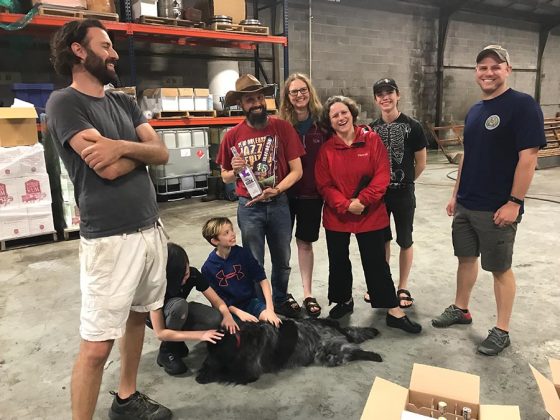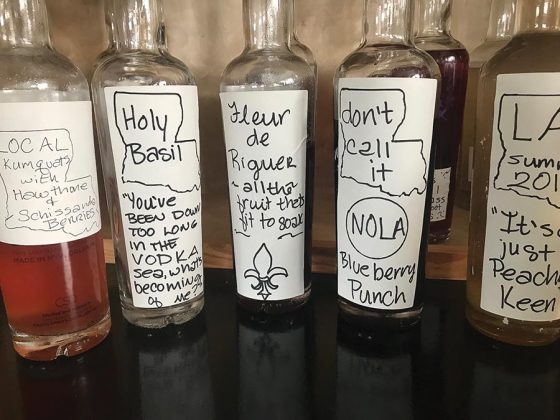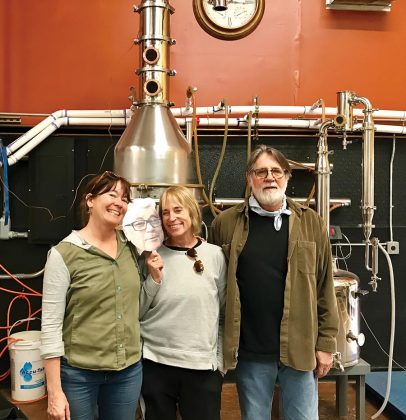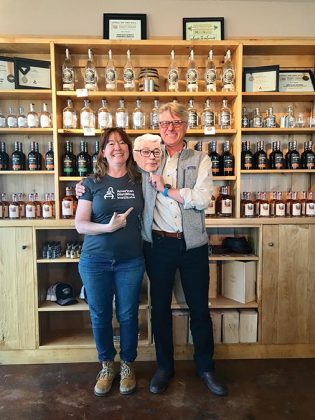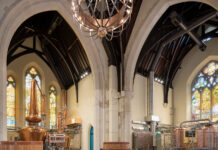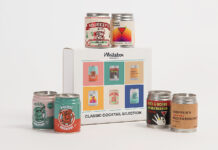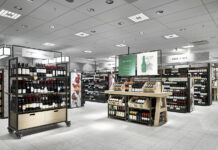“I was somewhere around Thumb Butte on the edge of the desert when the hankering for whiskey began to take hold.” — *not quite* Hunter S. Thompson
Am I paraphrasing one of my favorite fellow Kentuckians? Damn straight. Misquote me on it! Aside from inspirational fodder, let’s hit the Wayback Machine. [Cue cassette tape rewind sound effect here…]
It was a rainy Monday back in February, and I was sitting at a friend’s place in the Oakland hills after the sale of my home of 15 years. Grateful for a place to land, and at last able to take a breath after the final weekend moving push, “What,” I asked myself, “the hell comes next?”
After a long stint in online marketing, I was supporting myself with myriad side hustles. Stereotypically Californian as it sounds, I took up brewing kombucha and became fascinated with secondary fermentation. In this final phase, a natural source of sugar is introduced, along with other botanicals, to express specific flavors, then the bottle is capped to achieve effervescence. With access to an abundance of fruit from my own and neighbors’ backyards, as well as from local farmers markets, I fell deep into the rabbit hole of recreating my palate’s distant recollections from a youth spent in the bluegrass and the Carribbean.
These concoctions received enthusiastic feedback, and it dawned on me that I might be onto something. The coffee vacuum a friend gifted me was put to ill use and made victim in my attempts to extract flavored beverages sans schooling or sufficient knowledge. After a week of my aim being untrue, I recalled long-ago visits to bourbon manufacturers and my early impression of the distillation process as some magical alchemy. Perhaps this was the skill set I needed in order to capture what I sought to produce?
Some months prior, I’d reached out to Moonshine University in Kentucky to inquire about both classes and jobs. They informed me that if they were hiring, they’d post via the American Distilling Institute. I looked ADI up and noted they were down the road in Hayward. From where I sat in the hills of Oakland, it was a mere 20-minute drive. I studied the website, found a number and dialed it. A charismatic gent by the name of Bill Owens picked up. If a southern gal can talk, then Bill can charm the skin off a snake. Suffice it to say we hit it off just fine. Some 20 minutes into the conversation, I was asked if in order to learn to distill I’d go to New Orleans. I’m likely not the only one who holds that city near and dear, and it took me less than a millisecond to respond, “Oh, hell yeah!!” We met in person, got the details sorted and determined that due to my duty as a service person to a youngster of the canine persuasion by the name of Derby, this would be a road trip, destination Cajun Spirits in the Crescent City: New Orleans! I’d spend three months apprenticing there, visit small craft distilleries en route and summarize my visits in social media posts.*
“I’ve been everywhere, man / Crossed the deserts bare, man / I’ve breathed the mountain air, man / Of travel I’ve had my share, man.”
— Mr. Johnny Cash
I made numerous stops and met many distillers along my route through the Southwest and on the way back through Colorado and the Pacific Northwest. Most I visited are “grain to glass,” either milling the grain on-site or creating a syrup from fruit or produce to use in the fermentation on which the final spirit is based. Some serve as community gathering spots for music and events (Thumb Butte, Tumbleroot, Deerhammer) and others have such charming tasting rooms you’d think you were in a cocktail lounge rather than a production facility (Wood’s High Mountain Distillery in Salida, Colorado, and Still Spirits in Albuquerque).
Conversations with distillers covered a wide array of topics: including processes unique to their still set-up, filtration techniques and solutions for re-use of waste products generated by operations. Some hanker for a bottle designation to indicate “grain to glass” as a product not from bought neutral grain spirit. More than a few stated that, although vodka is commonly thought to be neutral in flavor, they were aiming for a flavor-forward spirit achieved via fermentation or filtration and often featuring a regionally prolific crop. Typically, much experimentation was carried out to get the balance of flavor sought.
I’d ask what was unique to their area or distillery, and was rarely disappointed, as this was often a segue into the tasting part of the visit. Don’t pass on the Atapiño Liqueur at Santa Fe Spirits or the Prickly Pear Vodka at Canyon Diablo in Flagstaff. Dana at Thumb Butte uses her past as an acclaimed baker to put together many savory vodkas, and Left Turn in Albuquerque is also producing a wide array of flavors. While Derby was thrilled to find other canines in most all distilleries, the common thread I found inspiring was all that I encountered were open in sharing information and answering questions candidly, and were generous in their time shared.
“In the Southland there’s a city / Way down on the river / Oh there’s some sweetness going around / Catch it down in New Orleans.”
— Dr. John
I rolled into New Orleans sometime around the midnight hour on a perfect southern night in April and found myself adjacent to Jacques-Imo’s, a classic establishment touting “warm beer, lousy food and poor service.” I dropped in for a tasty bowl of gumbo — a perfect way to begin my stay. Settling in for the night in my tiny house in the Black Pearl district, I found myself waking up early, regardless of my late-night arrival. Years of residing on the West Coast had accustomed me to the flexibility of tech industry work culture, so I was determined to be ready to start work at whatever early hour was deemed necessary.
I needn’t have worried. I texted Edward Haik, who was to be my mentor for the next three months, and was informed that “Wednesdays are a day off, but Saturday is a workday.” Elated to have time to explore and acclimate to my new environs, I walked by the river, where I met an older native Orleanian who regaled me with the history of the levee system and informed me it had reached a record high not broken in 90 years. These history lessons from local folk were frequent, and as a Southerner with a French-Canadian father, partially raised in the Caribbean, I’d found my ideal cultural mélange.
Cajun Spirits was started by Gus Haik upon returning home to New Orleans from a stint in the navy where he distilled drinking water from saltwater. He saw an opening for producing spirits from the region’s plentiful sugarcane. With a background in engineering, he laid the groundwork with city planners to secure permits and broke trail for numerous distilleries to open shop in New Orleans. Lest you think small craft distilling is a surefire way to get rich, Gus has a full-time engineering position to keep the boiler on, the botanicals coming in and fine spirits flowing out. The day-to-day distilling operations are handled by Edward, Gus’s brother, who was previously a teacher.
Their aim is to produce approachable yet distinct spirits rich in the essence of their beloved home region. They take sugar from Louisiana-grown cane and make a raw syrup on-site. Using a combination of yeasts and enzymes determined after much testing and tasting, a “sugar wine” is produced. While I was accustomed to the aroma of a bourbon mash reminiscent of Grandma’s kitchen with cornbread in the oven, this was an equally distinct yet cleaner smell to my nose: of dough rising with grassy overtones. This concoction is pumped over to a German-made, 300-gallon Holstein still, affectionately called “Big Baby.” The smaller 8-gallon copper still, reverently dubbed “Grandma” is utilized for gin, and when duty calls, doubles for flavor experimentations and recipe development.
Crescent City Vodka has the clean, smooth profile of a sugarcane-based spirit. The brothers take advantage of the various botanicals coming off the still at different points in the run to selectively reduce or amplify flavor components. Their 3rd Ward Gin is rich in flavor but not overtly juniper-heavy. Proximity to prime sugarcane fields provides a perfect locale to make rum, and the brothers have produced the lighter Tresillo Rum and have a darker rum barrel aging.
Aside from forklift operation, I participated in all stages of production, from pumping the syrup mix to the fermentation tanks, pitching the yeast and enzymes and checking this mixture for sugar, pH level and alcohol content until it was ready for the next phase. Initially I used the smaller still, preparing the botanicals for gin distillation and running Grandma from start to final distillate. I learned the key component of “blessing the gin” as the still door closes. Should you subscribe to the theory of “sonic aging” as Copper & Kings in Louisville does, it’s safe to say many Cajun Spirits bottles are infused with LCD Soundsystem. Eventually, I ran Big Baby and learned its unique quirks in order to get the most out of both the stripping and final runs.
The brothers keep comprehensive notes on all processes, which serves learning well. I could refer to former runs and learn to identify patterns of various stages of the run while using instrumentation to get precise readings of temperature and proof on the distillate.
And of course: bottling. More than once I conjured images of Laverne & Shirley… “Schlemiel, schlimazel.” You stay late, blast some tunes and get it done.
A family collaboration in every sense, I’d wager they’re the only distillery with an ophthalmologist on the bottling line, as Gus’s wife Erin gives a hand toward getting the thousands of bottles heading out the door. It’s all hands on deck to bottle, label, cork, check quality. Then it’s stickered, sealed, delivered — it’s yours.
The Big Easy lives up to its name in more ways than one, and it’s nearly effortless to meet people. I befriended vendors and growers from farmers markets and community gardens. It became clear that I was back in the South when a quick walk around the block with the pup took an hour, as talkative neighbors proved an excellent resource for fruit, herb gardens and deep knowledge of local flora and seasonality.
Before long, I was churning out infusions featuring ingredients procured from foraging, community gardens and buying from markets. Utilizing local herbal shops to procure hard-to-find botanicals, I produced a wide array of infusions. First was honeycomb-infused vodka from my Oakland backyard bees. Cajun Spirits does an annual loquat infusion and also takes advantage of Louisiana’s famed Ponchatoula strawberries. As the season changes, these are followed by blueberries and peaches. A single-fruit infusion made with muscadine grapes was a hit, as was an infusion of sweet and earthy corn silk, inspired by a traditional First Nation tea. Working with fresh tamarind is labor-intensive, but the rewards in flavor pay out nicely. Cajun Spirits sponsors a piano night at local venue The Maple Leaf, and a new infusion is brought to the bar weekly. A riff on a Caribbean punch made from hibiscus flowers, ginger, star anise, citrus peel and cardamom was a hit, as were combinations such as strawberry/fennel, grapefruit/rosemary and jalapeno/watermelon/mint.
Aside from the popular piano night, the distillery also appears at events such as “Eat Local Month” and provides tastings featuring their spirits. We did a multitude of combinations and tested which flavors various parts of the plants produced. For example, we would test cilantro not just as seed, but the green seed versus ripened or toasted, and then using just the flower or only the green leaves. Multiple varieties of citrus, berries, edible flowers and herbs were put in play to tasty effect. I’m fortunate my mentor encouraged creativity and provided latitude to experiment widely with flavors.
Toward the end of my stint, Louisiana summer was in full swing. I was reminded of a friend’s observation on learning to scuba dive: If you can learn to dive in the cold, murky water of Monterey Bay, all future expeditions are a cakewalk. If your brain and body can cooperate to function in the sweltering heat of a New Orleans summer adjacent to a running still, you might be able to handle this gig in any clime. Know that if you visit, you’ll get an informative tour of the distillery and then hit the air-conditioned tasting room for samples.
“On the road again / I just can’t wait to get on the road again”
— Willie Nelson
I’m being facetious, as July’s humidity had me not at all singing Willie’s hit. If not for the pooch, I’d have gladly chucked all my possessions and jumped on a plane back to the cool clime of the San Francisco Bay. Instead I gamely pointed my car northward and proceeded to have an epic, awe-inspiring adventure. By
Day 2, I pulled out of Canton, Texas, with a carnitas taco in hand, fully hooked on life on the road. Opting for byways over highways, I explored some of the American West’s most charming towns and regions of stunning natural beauty. Is there a better way to relax under a dark, starred sky than to sip on a cocktail of spirits produced by a distiller friend while young elk bucks descend from the hills into your campsite? Waking up with a swim in a glacial-fed river on a hot summer morning is the icing on the proverbial cake.
In Colorado, I was surprised by the Great Sand Dunes National Park and Preserve, charmed by earthship homes in Crestone and fully smitten with the Arkansas Valley. The beauty of Grand Teton and Yellowstone is phenomenal in magnitude. Washington’s Cascade Loop and Olympic Peninsula are equally jaw-dropping, as are the dramatic cliffs and dunes on the coast of Oregon. Some 10,000 miles of asphalt sliding by under my little hatchback, a new car battery, one radiator and four tires later, I’ve no doubt the best tonic for the heart and soul during life’s transitional phases is to follow your passion to learn a new skill and launch oneself into the wild, natural beauty of the country surrounding us.
I’m immensely grateful that the American Distilling Institute offers sponsorships for those who learn best hands-on, and my eternal thanks go to the Brothers Haik at Cajun Spirits for being up to taking on mentorship of an enthusiastic beginning distiller. Please drink responsibly and pack a flask to imbibe safely after you’ve settled in for the night. Cheers, y’all!
*Find highlights of the apprenticeship and trip on Instagram @BourBonVoyage

